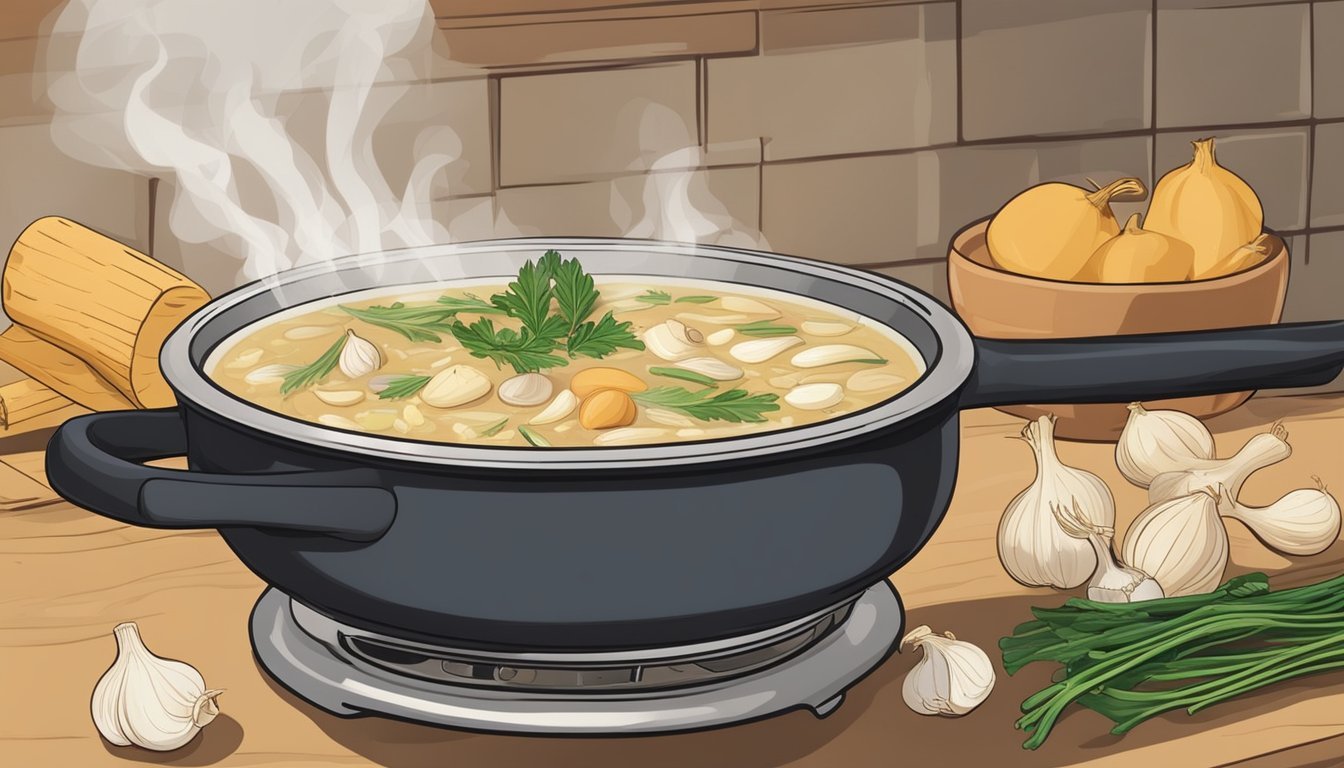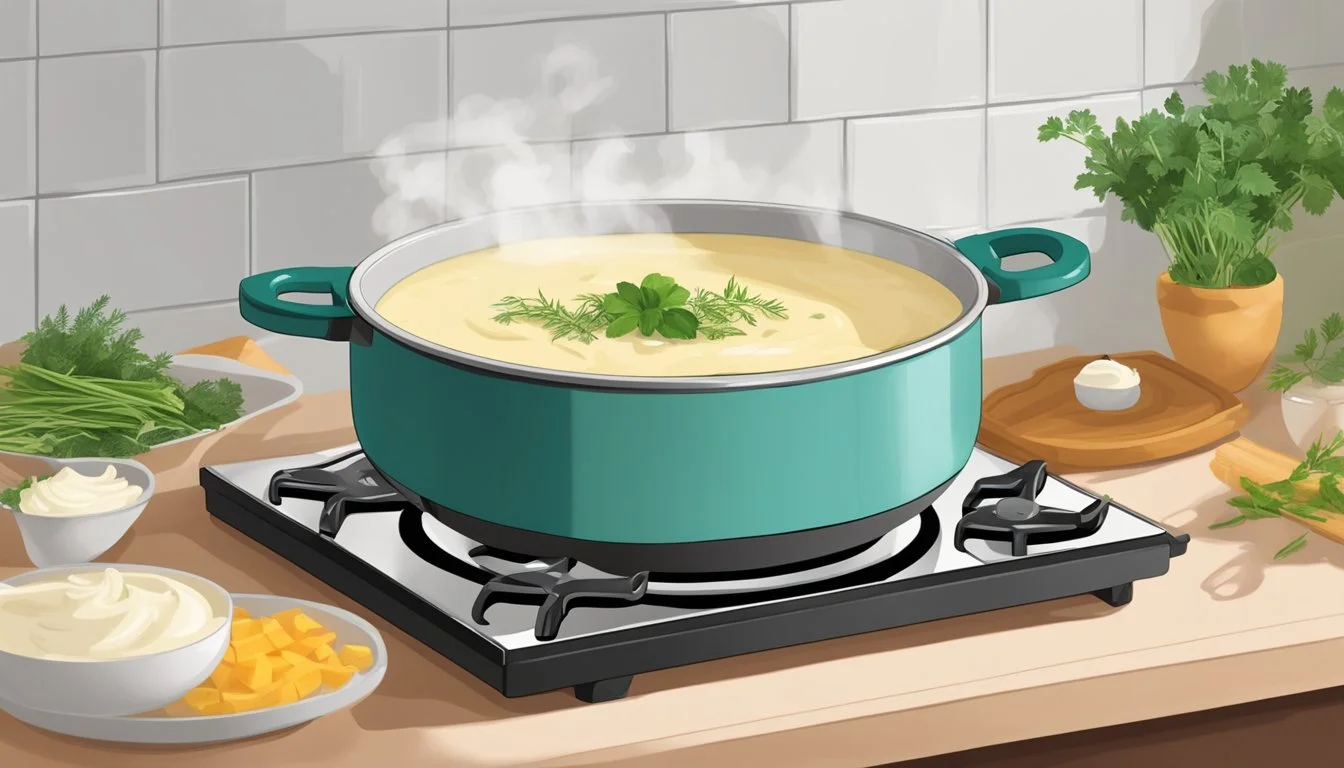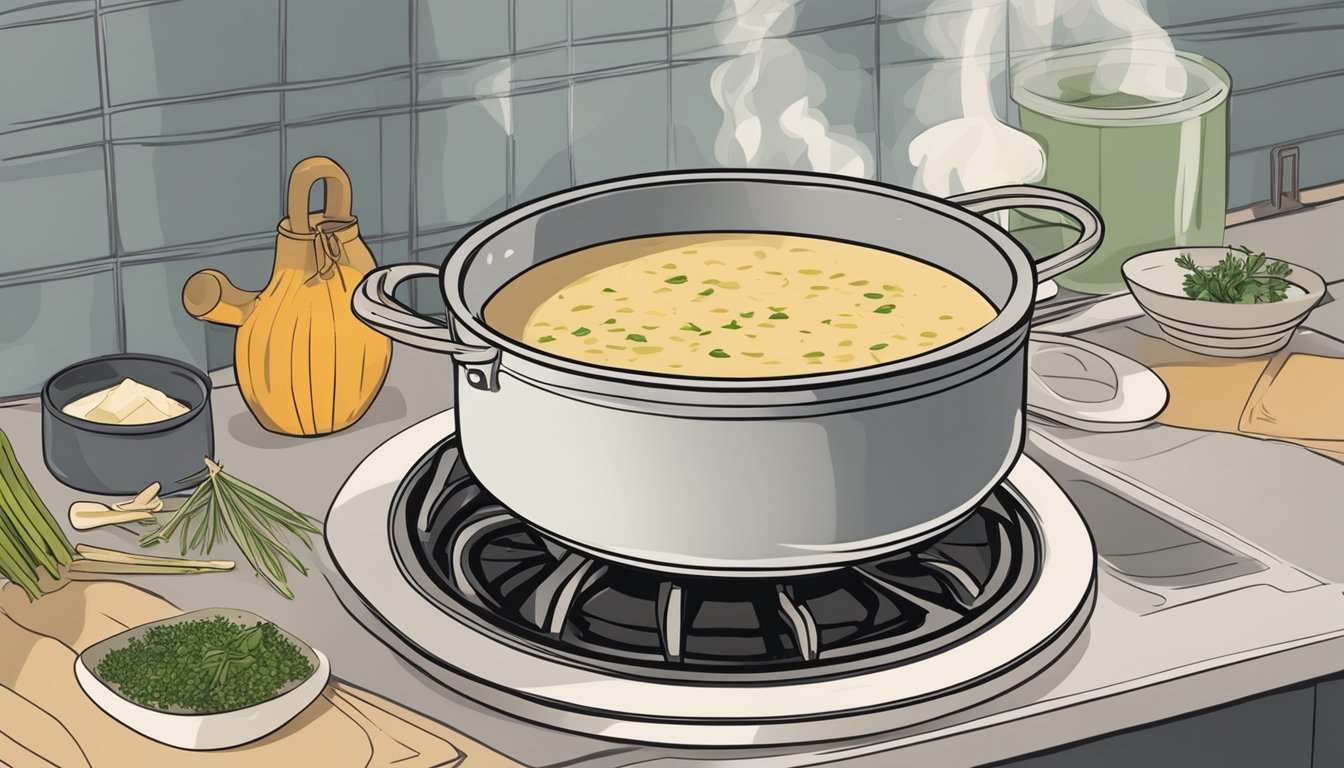Parsnip Peel Soup
A Creamy, Earthy Starter Perfect for Health-Conscious Diners
Parsnip peel soup emerges as a celebration of resourcefulness and flavor, offering a creamy and earthy taste that is both comforting and sophisticated. Traditionally overlooked, the peels of parsnips contain a bounty of flavor and nutrients, making them an ideal base for an eco-friendly and delicious soup. This starter dish is gaining popularity among home cooks and professional chefs alike for its velvety texture and subtle sweetness, enhanced by the natural earthiness of the parsnip peels.
The preparation of parsnip peel soup is a testament to the philosophy of zero-waste cooking, utilizing parts of vegetables that might otherwise be discarded. Parsnips, a root vegetable related to the carrot, have a nuanced flavor profile that becomes more concentrated in the peels. When simmered into a soup, these peels infuse the broth with a distinct taste that is gently amplified by traditional seasoning and aromatics.
Parsnip peel soup serves not only as a statement on sustainable eating practices but also as a gateway to exploring the depths of uncharted flavors in everyday ingredients. It stands on its own as a warming and inviting first course that sets the stage for a mindful and satisfying meal, anchoring itself in the realm of modern culinary innovation with ease and elegance.
Nutritional Profile of Parsnips
Parsnips are a root vegetable that boast a rich nutritional profile. As a fibrous food, they contribute effectively to digestive health. A single medium parsnip (approximately 6-8 inches long) provides about 3 grams of fiber.
Vitamin C is another significant nutrient found in parsnips, offering immune system support and playing a role in collagen production. A medium parsnip can provide around 17% of the recommended daily intake of vitamin C.
Regarding potassium, parsnips are a good source, helping to maintain normal blood pressure and supporting proper muscle and nerve function. A medium parsnip contains approximately 375 milligrams of potassium.
Here's a brief breakdown of the nutritional content of parsnips:
Nutrient Amount per Medium Parsnip (approx. 100g) Calories 75 Fiber 3g Vitamin C 13mg Potassium 375mg Carbohydrates 18g
Parsnips contain a range of other essential micronutrients as well, such as folate, vitamin K, and various B vitamins, contributing to a well-rounded diet.
Above all, parsnips' low-calorie count paired with their nutrient density makes them an excellent choice for those looking to maintain or enhance their nutrition.
Essential Ingredients and Alternatives
The success of a creamy parsnip soup depends on a balance of "essential ingredients" and the chef's creative flair with "alternatives". Depending on dietary preferences or available pantry items, various substitutes can provide flexibility while maintaining the integrity of the dish.
Main Ingredients
Parsnips: The star of the soup, offering a sweet, nutty flavor.
Onion and Garlic: For a foundational aromatic base.
Cream: Adds richness; heavy cream or half-and-half are common choices.
Stock and Soup Bases
Chicken Stock: Ideal for a non-vegetarian soup base, enriching the soup’s depth.
Vegetable Stock/Broth: A vegetarian option that complements the parsnips without overpowering them.
Flavor Enhancers
Herbs: Thyme and bay leaf are traditional choices.
Salt and Pepper: Essential for seasoning and enhancing the natural flavors.
Optional Additions
Vegetables: Carrots, leek, or celery can be added for complexity.
Starchy Vegetables: A potato can contribute to a thicker consistency.
Health-Conscious Substitutions
Olive Oil: For a lighter option compared to butter.
Vegan Cream: To cater to vegan diets, coconut cream or other plant-based alternatives can be used.
Garnishes and Toppings
Herbs: Parsley or chives provide a fresh contrast.
Nuts: Toasted hazelnuts add a delightful crunch and flavor.
Croutons: For a touch of texture.
Cheese: A sprinkle of grated cheese can be a savory addition for non-vegan variants.
Step-by-Step Cooking Guide
This guide will lead the reader through the creation of a creamy parsnip peel soup, detailing each stage of the process from vegetable preparation to the final presentation.
Preparing the Vegetables
To begin, parsnips should be thoroughly washed to remove any dirt. Next, peel them and set aside the peels for the soup, as they are packed with flavor and nutrients. The parsnip flesh can be cut into even, small chunks to ensure uniform cooking. Additional vegetables like onions and garlic will also need to be minced, as they will contribute to the base flavor of the soup.
The Blending Process
Once the vegetables are tender, it's time to turn the cooked ingredients into a smooth puree. An immersion blender is perfect for this task, allowing one to blend directly in the Dutch oven or pot. If a regular blender or food processor is being used, ensure the mixture is cooled slightly to avoid accidents due to the expansion of hot liquids.
Simmering to Perfection
After achieving a smooth puree, return the soup to the stovetop and let it simmer. This process allows the flavors to meld together and the parsnip to truly shine, becoming creamy and developing a subtle sweetness as it caramelizes slightly. For those aiming for a vegetarian dish, vegetable stock is recommended. The simmering should be managed closely to avoid scorching.
Serving Suggestions
Serve this earthy starter hot, perhaps with a garnish of fresh herbs or a drizzle of cream to add richness. Pairing the soup with a slice of crusty bread makes for a satisfying appetizer or a light yet hearty side dish. The blend of creamy texture with the complex, sweet notes of the parsnip makes each spoonful a delightful prelude to the main course.
Taste and Texture
The section delves into the essential aspects of crafting a parsnip peel soup that is recognized for its creamy texture and balanced flavor profile, embodying a medley of sweetness and spices.
Achieving Creaminess
To achieve the desired creaminess in a parsnip soup, chefs often incorporate ingredients like cream and butter. However, for a lighter variation, substitutes such as puréed cooked parsnips or a splash of heavy cream are recommended to maintain the velvety consistency. When blended, cooked parsnips naturally lend a creamy texture to the soup which can be enhanced with these dairy additions.
Balancing Sweetness and Spices
Parsnip soup carries a slightly sweet taste due to the natural sugars found in the vegetable. The sweetness can be nuanced with the addition of spices:
White pepper: adds a subtle peppery punch.
Ginger: introduces a warm, slightly spicy flavor.
Red pepper flakes: offer a mild heat that contrasts the sweetness.
Nutmeg: complements the soup with its nutty and sweet characteristics.
A balanced approach ensures that no single taste overwhelms the delicate flavor of the parsnips.
The Role of Roasting
Roasting parsnips before incorporating them into the soup profoundly impacts both taste and texture. Roasted parsnip soup obtains a deeper, more robust flavor profile compared to one made with boiled parsnips. The caramelization that occurs during roasting enhances the natural nuttiness and sweetness, adding complexity to the soup's taste. Additionally, roasting helps in creating a smoother soup as it softens the parsnips, making them more pliable for blending into a creamy texture.
Pairing and Serving
A carefully chosen accompaniment or wine pairing can elevate Parsnip Peel Soup from a simple starter to a memorable part of a meal. Here are specific pairing suggestions to consider.
Accompaniments
For those serving Parsnip Peel Soup as an appetizer, it can be accompanied by:
Crusty Bread or Rolls: A slice of warm bread complements the soup’s creamy texture and earthy flavor.
Salad: A fresh, light salad with vinaigrette balances the soup's richness and serves as a palate cleanser.
Additionally, croutons offer a delightful crunch, and a swirl of cream or a sprinkle of herbs can enhance the presentation and taste.
Wine Pairing
When it comes to wine, one should look for options that pair harmoniously with the soup’s creamy and earthy characteristics. A white wine with good acidity and a hint of fruitiness is ideal. Suggested pairings include:
Chardonnay: With its full body and hints of oak, it matches the soup's creaminess.
Sauvignon Blanc: Its zestiness can cut through the richness of the soup.
Both wines should be served chilled to act as a refreshing counterpoint to the warm soup.
Storage and Reheating Tips
Proper storage and reheating methods are crucial for maintaining the taste and safety of Parsnip Peel Soup. This section will guide readers through optimal practices for preserving leftovers and reheating this delightful winter soup.
How to Store
Parsnip Peel Soup should be stored in an airtight container to keep it fresh. One can refrigerate the soup for up to 3-4 days. For longer storage, freezing is an effective option. To freeze, let the soup cool completely, then transfer it to freezer-safe bags or containers, leaving some space for expansion. Label with the date, and it can be stored for up to 2-3 months.
Best Methods for Reheating
When reheating leftovers, the soup should be brought back to a simmer to ensure even heating and to restore its creamy texture. The best methods include:
Stovetop: Pour the soup into a pot and reheat on a medium setting, stirring occasionally.
Microwave: Use a microwave-safe dish, cover with a lid, and reheat in short intervals, stirring in between to distribute heat evenly.
Note: Thaw frozen parsnip soup in the refrigerator overnight before reheating.
Making Soup in Bulk
For those engaging in meal prep or wanting to make Parsnip Peel Soup ahead of time, preparing it in a one pot method is efficient. Once cooked, allow the soup to cool. Afterwards, it can be portioned into single servings, which makes it easier to thaw only what is needed. After following the freezing and reheating tips above, one can enjoy a hearty bowl of soup without the need for daily cooking.
Recipe Variations and Tips
This section provides specific guidance on customizing the creamy parsnip peel soup to various diets and enhancing flavor profiles with different herbs and spices.
Vegan and Dietary Variations
For a vegan version of parsnip peel soup, one can substitute the chicken stock typically used with a rich vegetable broth. Instead of butter or other animal fats for sautéing, one might opt for olive oil or coconut oil. To achieve creaminess without dairy, ingredients such as coconut milk or cashew cream can be excellent alternatives.
When considering diets such as gluten-free or paleo, ensure all stock used is free from gluten-containing additives. Additionally, for a paleo-friendly soup, avoid grains and legumes and consider toppings like toasted nuts instead of croutons.
Substitutions for Creaminess:
Vegan: Coconut milk, cashew cream
Paleo: Almond milk, pureed cauliflower
Herbs and Spices Alterations
The classic parsnip peel soup recipe often calls for dried thyme, a herb that complements the earthy tones of the root vegetable. However, one can explore with fennel seeds for a sweet, anise-like flavor or sage for a more robust note. Here is a table of herb and spice recommendations:
Herb/Spice Flavor Note Suggested Quantity Dried thyme Earthy and subtle 1 tsp Fennel seeds Sweet and licorice-like 1/2 tsp Sage Pine-like, peppery 1/2 tsp
To change the soup’s profile, one might consider garnishing with herbs or including a spice blend during the cooking process. Fresh herbs can also be used as a garnish, adding both flavor and visual appeal. Choose herbs that complement or contrast with the existing flavors for a more complex taste experience.
Topping Variations:
Fresh parsley, chopped
Roasted hazelnuts, chopped
Pear slices, for sweetness
By adjusting the recipe with these variations and tips, one can cater to diverse preferences and dietary requirements without compromising on the soul-warming essence of creamy parsnip peel soup.
Cultural and Historical Context
Parsnip soup holds a rich tapestry in culinary tradition, elegantly connecting the roots of historical cuisine to modern table delicacies. Its development has been influenced by cultural preferences and available ingredients across various regions and time periods.
Parsnip in Cuisine
Historically, the parsnip, a member of the apiaceae family, has been a fundamental root vegetable in European cooking, particularly in British cuisine. They are celebrated for their sweetness, brought out further when cooked, which complements the winter months well. Parsnips have been utilized in both sweet and savory dishes, with their presence in soups (What wine goes well with soups?) being a testament to their versatility and appeal during colder seasons.
Noteworthy historical points:
Ancient cultivation: Parsnips were cultivated by the Romans and have been a staple in Britain since the 16th century.
Sweetness over time: It was historically used as a sweetener before the widespread use of cane sugar.
Evolution of Soup Recipes
Throughout history, soups have often provided a means to create nourishing and satisfying meals from limited ingredients. Vegetable soups, in particular, have taken advantage of the hearty textures and flavors of root vegetables. Parsnip soup recipes have evolved to highlight its earthy flavor and creamy texture, with traditional ingredients like bacon adding a depth of taste.
Key transformations:
Early recipes: Soups were once simple, seasoned broths.
Modern versions: Contemporary recipes often incorporate pureeing techniques for a smoother consistency.
Famous Pairings with Parsnip Soup
Parsnip soup pairs famously with a variety of flavors and ingredients. Common accompaniments can include apple or pear, which emphasize the sweetness of the parsnip, while others prefer savory contrasts like crisped bacon or turkey as a nod to its British roots.
Classic pairings:
Savory: Bacon or turkey offer a rich, meaty counterbalance.
Sweet: Apple and pear complement and enhance the natural sweetness of the parsnip.
Frequently Asked Questions
This section aims to address common queries about preparing and serving Parsnip Peel Soup, offering practical tips for enhancing the dish, preserving, and giving it a new lease on life as leftovers.
Preparing Parsnips for Soup
When preparing parsnips for soup, it's important to clean and peel them thoroughly to eliminate any dirt or bitter skin. Parsnips should be cut uniformly to ensure even cooking. For a creamier soup, parsnips can be roasted before adding them to the pot, which will bring out their natural sweetness.
What to Serve with Parsnip Soup
Parsnip Soup, often enjoyed as an appetizer or side dish, pairs excellently with crusty bread or a green salad. For a heartier meal, one could serve it alongside a protein such as roasted chicken. (What wine goes well with roasted chicken?) For a vegetarian option, a quinoa or barley salad complements the earthy flavors (What wine goes well with earthy flavors?) of the soup.
Alternatives to Cream in Soup
For those seeking a healthier option or catering to vegan guests, the cream in Parsnip Soup can be replaced with alternatives such as coconut milk, which imparts a rich texture and subtle flavor. Other options like almond or oat milk can also be used to maintain creaminess without the dairy.
Storing and Reusing Soup
To store leftovers, allow the soup to cool before transferring it to an airtight container. It can be refrigerated for up to three days or frozen for up to three months. Reheat the soup on the stove over low heat to preserve its texture. If frozen, thaw it in the refrigerator overnight before reheating.









